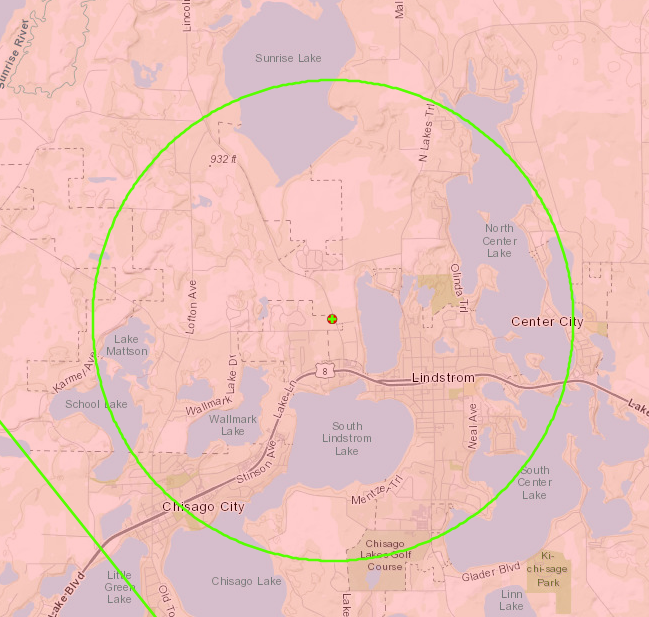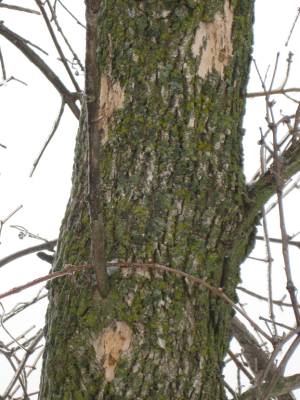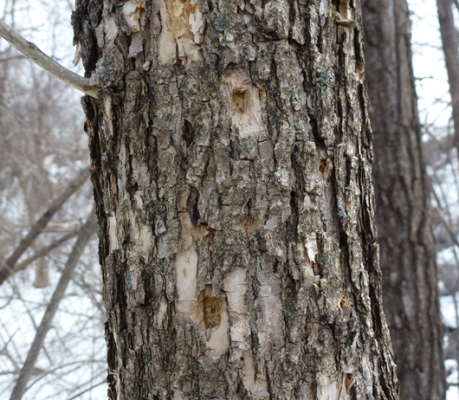Emerald Ash Borer
As of late 2022, the Minnesota Department of Agriculture (MDA) has confirmed an infestation of emerald ash borer (EAB) in the city of Lindström after and MDA employee was traveling through the area and identified an infested tree. This is the first confirmed report received by the MDA in Lindström. The infested tree is located along Lincoln Road just north of Stacy Trail.

Infested locations will appear on MDA’s EAB status map. Lindström property owners should consider the city to be generally infested with EAB, meaning any ash tree not currently being treated with insecticide has a high likelihood of being infested at some level whether showing signs or not.
There are several things residents should look for when checking for emerald ash borer:
- Be sure you’ve identified an ash tree. This is an important first step since EAB only feeds on ash trees. Ash have opposite branching – meaning branches come off the trunk directly across from each other. On older trees, the bark is in a tight, diamond-shaped pattern. Younger trees have a relatively smooth bark.
- Look for woodpecker damage. Woodpeckers like EAB larvae and woodpecker holes may indicate the presence of EAB.
- Check for bark cracks. EAB larvae tunneling under the bark can cause the bark to split open, revealing the larval (S-shaped) tunnels underneath.
- Contact a professional. If you feel your ash tree may be infested with EAB, contact a tree care professional, your city forester, or the MDA at reportapest@state.mn.us or 888-545-6684 (voicemail).
Emerald ash borer larvae kill ash trees by tunneling under the bark and feeding on the part of the tree that moves nutrients up and down the trunk. Minnesota is highly susceptible to the destruction caused by this invasive insect. The state has approximately one billion ash trees, the most of any state in the nation. The biggest risk of spreading EAB comes from people unknowingly moving firewood or other ash products harboring larvae.


There are three easy steps residents can take to keep EAB from spreading:
- Don’t transport firewood. Buy firewood locally from approved vendors, and burn it where you buy it;
- Be aware of the quarantine restrictions. If you live in a quarantined county, be aware of the restrictions on movement of products such as ash trees, wood chips, and firewood; and,
- Watch your ash trees for infestation. If you think your ash tree is infested, go to https://www.mda.state.mn.us/eab-info-homeowners for resources on identifying EAB, how to hire tree care professionals, and insecticide options for protecting your ash tree.
EAB Information and Resources:
- There is an upcoming EAB informational webinar for residents, natural resource managers, and tree care professionals that covers the basics of EAB biology, detection, management and regulations on Wednesday, January 18, 2023 at 10am. To register for this webinar or future webinars, view the presentation at a future date, or view past webinars, visit the MDA website: https://www.mda.state.mn.us/eab
- Danielle DeVito is the regulatory contact for all things EAB quarantine related (danielle.devito@state.mn.us or 507-384-1129) (https://www.mda.state.mn.us/plants-insects/emerald-ash-borer-quarantine).
- MDA’s Guidelines to Slow the Growth and Spread of EAB (Comprehensive guidelines and with lots of links to resources)
- U of M Extension’s list of recommended trees for Minnesota. https://extension.umn.edu/tree-selection-and-care/recommended-trees-minnesota
- MN DNR Community Forestry Grant Opportunities will be posted at https://www.dnr.state.mn.us/forestry/urban/index.html
- Information resources for natural resource professionals https://www.mda.state.mn.us/eab-info-resource-professionals. There is a list of outreach material on this webpage. The main ones we use are EAB ID Cards, "Does my tree have EAB?", Homeowner Guide to Insecticide Selection, Insects Commonly Confused with EAB, and Recognizing Insect Galleries in Ash.
- MDA Staff will be available in the fall/winter to help train city staff on early detection of infested trees and perform a visual delimit survey to identify visibly infested trees.
It is important for property owners to begin making decisions regarding their ash trees. If property owners want to save their ash trees, then they should begin having their trees treated with insecticide. More information for homeowners can be found at: https://www.mda.state.mn.us/eab-info-homeowners
Hennepin County has also created a useful flow chart for residents that lays out a decision guide for managing ash trees.
The basic options for a property owner are the following:
- If the ash tree still looks healthy enough after leaf out (no more than 30% canopy decline), you can begin having it treated with insecticide to begin protecting it this spring/summer. This is an annual or biennial expense and best to have a certified arborist assess the health of the tree and apply the treatment. If the tree is over 15” in diameter at breast height it is important to have a licensed pesticide applicator treat the tree. The chemicals available to the average homeowner typically aren’t rated for trees that size or larger. Homeowners guide to insecticide selection
- If the tree is past the point of being a good candidate for treatment or would prefer not to go that route, plan to do removals during fall, winter or early spring. Try to avoid doing any pruning or removals during the summer months when EAB is actively flying around. Ash trees become very brittle and hazardous quickly after they die and that can greatly increase removal costs depending on where it happens to be located in the yard. It typically takes about 3 years for signs of infestation to become initially visible (i.e. woodpecker damage in branches 3-5 inches in diameter) and a total of 5-6 years for EAB to kill the tree.
- If the ash trees are in a natural area where they don’t pose hazards to persons or property, they can be left to die and fall apart.
- As for the wood, it is best if it can be kept as close to where it was cut as possible. You can save it for firewood and burn on-site if you have a fire pit, bring to closest tree waste disposal site, or have a tree care company haul it if you hire one to cut the tree. It is just important that the wood doesn’t get hauled outside of the known infested area and emerald ash borer quarantine restrictions are followed.
For more information on emerald ash borer, go to www.mda.state.mn.us/eab
All of the above information was provided by: Jonathan Osthus, Minnesota Department of Agriculture, Pest Detection & Export Certification Unit, Plant Protection Division www.mda.state.mn.us
